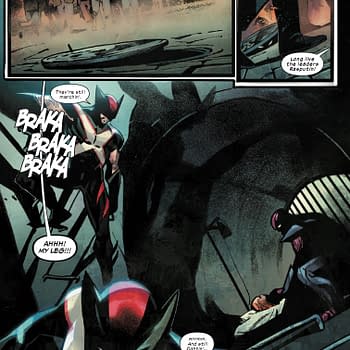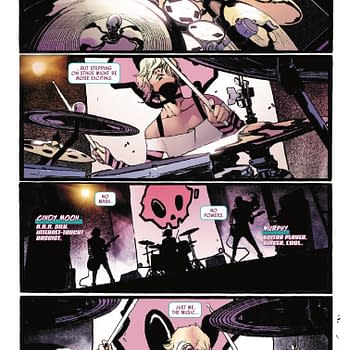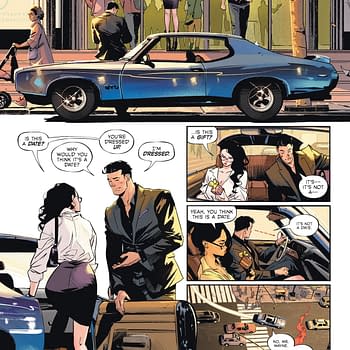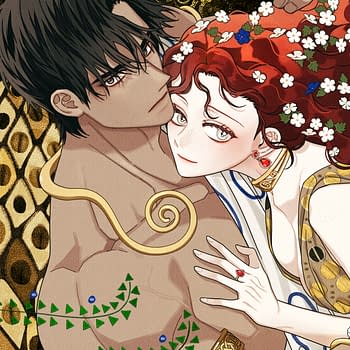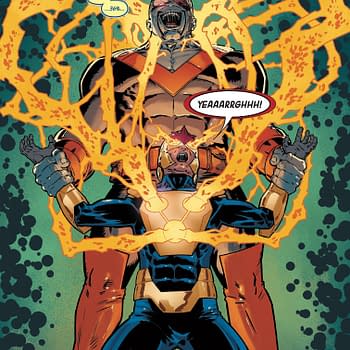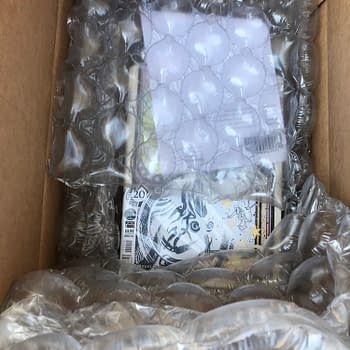Posted in: Comics, Recent Updates | Tagged: 12 Reasons to Die, Adam Wallenta, Carolina Acuni, Comics, entertainment, Eric Orr, hip hop, Khari Randolph, Matthew Rosenberg, New York Comic Con 2014, Patrick Reed, Pete Rock, Ron Wimberly, Sasha Kimiatek
Beats, Rhymes, Panels, And Pages At The Hip-Hop And Comics: Cultures Combining Panel At New York Comic Con
By Ra'Chaun Rogers
Growing up in NYC two things were constant for me, comic books and Hip-Hop. Both cultures always seemed so naturally linked in my mind but seemed so far away in mainstream society, so it was greatly refreshing when I found out that there was a panel devoted to finding the connection between both.
Patrick Reed from Depth of Field Magazine moderated the panel and opened the panel by introducing Carolina Acuni, journalist and scholar in both subjects, Adam Wallenta, musician and co-creator of the Public Enemy comic with Chuck D., artist Khari Randolph, of Tech Jacket. Legendary Producer Large Professor, Matt Rosenberg, writer of Ghostface Killah's Twelve Reasons to Die, Ron Wimberly, artist on The Prince of Cats, Eric Orr, creator of Rappin Max Robot, the first rapping comic book, Sasha Kimiatek, artist, graphic designer and cartoonist. Last but certainly not least the legendary Pete Rock.
Patrick asked each person what brought them to this panel and what they feel the cultural significance between hip-hop and truly is. Eric started off by thanking Patrick who found his book sitting in his(Eric's)mother's house and brought it to Cornell to be curated as part of Hip-Hop and comic books history. He also felt like both had been a part of his life, starting off with the comics in the newspaper, this is what made him do a rap comic. Adam chimed in saying that he felt the two mediums followed along the same path. In the 70's comics and rap were about self awareness, which bled into the 80's spawning an era of gritty art which both seemed to embrace. He didn't feel he saw that sort of parallel in other genres.
Ron, however did and felt that his comic Prince of Cats wasn't a hip-hop comic per se but more punk, however when he and Patrick examined the elements of the comic they realized it in fact was more likened to Hip-Hop than any other genre. The idea of Prince of Cats came from the notion that Hip-Hop was like someone stole the mic the same way that Tybalt was killed halfway through Romeo and Juliet. Large Prof made a great point where he said that rap stage names are like superhero alter-egos, When people get on the stage they're wearing that mask, even the B-boy stances are from Superhero poses.
Carolina mentioned that her father worked in music but also knew comic book creators like R.Crumb and was into a lot of underground art which is how she was first introduced to the music of Ice Cube. Both have been in her background for a long time. Sasha admitted she didn't start out in the world of Hip-hop like the others but was into anime and noticed that works like Samurai Champloo made a great comparison between emcee's and Ronin (Masterless Samurai). It was after this consideration that she became interested in the genre. Pete Rock spoke and the room nearly exploded as he recounted his love of the Hulk and cited it as the inspiration for how he produces as well as claiming to be a Marvel boy through and through.
When asked what it was like to work with actual rappers, Matt explained how he wanted Twelve Reasons to be an authentic work of Hip-hop fiction and not something exploitative. He recalled an old Jim Lee style graffiti image of Cyclops on a box truck blasting away someone's Tag, and he didn't want it to be like that, which is the public view of Hip-Hop. He wanted to explore the history and so when he sat down with RZA and Ghost he came up with a way to do that. Khari chimed in laughing wishing that his work on the Big Pun, Ludacris comic was as fun or involved, saying that the only interaction he got with the artists was Lil' Kim telling him to make her boobs bigger.
I thoroughly enjoyed this panel since it was one people wouldn't automatically think to go to or even consider but that just goes to show why it was needed in the first place. It served as a uniting force for two things that seem to have nothing in common but indeed have quite a bit.













